Trek pulled out all the stops with their CrossRip+ electric road bike. This thing comes in five sizes, includes sturdy full-length Aluminum alloy fenders, a custom designed rear rack with light integration and sturdy pannier rods, reflective paint and tire stripes, and an aimable three-mode integrated headlight! You get a SRAM 1×11 drivetrain, which means considerably fewer gears than the non-electric CrossRip line which range from 18 to 22 speed… but this is actually at the high end for Bosch powered mid-drive electric bikes. The one-by drivetrain reduces complexity, means fewer adjustments and chain drops, and is quite capable given the power of electric assist. The derailleur features a clutch system to improve tension and reduce slap when you go off-road, and the 20 tooth chainring (equivalent to a 50 tooth traditional chainring) is shielded by an alloy chainring guard that reduces drops while simultaneously keeping pants clean and snag-free. Because the motor controller offers software-driven shift detection, shifting remains relatively smooth even when the motor is operating at high power. Internal cable routing and a flattened downtub create a blended look, the black plastic casing on the motor and battery work well here because the frame color is matte black, but the battery is still external and the motor is not tilted and semi-integrated the way that it is on some of the latest mountain models or with alternative motor systems from companies like Brose. But, the even distribution and relative light weight of the bike (roughly 46 lbs) make it a standout. Some of the fancier battery and motor designs can be more difficult to remove in my experience and require a bit more frame reinforcement which probably adds weight. The CrossRip+ rides beautifully, even when the motor is turned off. The cockpit is clean and the single-paddle shifting mechanism on the right hood is simple once you get used to it (short click for higher gears, longer two-click or three-click for lower gears). This bike even comes with a small flick bell, easy-reach light switch beneath the display, and an adjustable length rear-mount kickstand… though it began to rattle when I took the bike off-road so consider removing it, tightening it, bringing a tool along, or using Loctite Blue if you encounter similar noise. The Trek CrossRip+ is feature complete and more than just a road bike. Larger tires provide cushion, stability, and gravel riding options, they can be setup as tubeless because the rims support it, and I fully enjoyed the SRAM hydraulic disc brakes with 180/160 mm rotor setup. I was able to stop adequately with just the front brake while filming and descending. There are only a few options in the road e-bike category right now in the US that I have seen, and the Trek CrossRip Plus is leading the pack in my opinion.
Powering the bike is a dynamic Bosch Performance Line Speed motor. This is the motor that can reach 28 mph (45 kph) vs. just 20 mph, and it’s perfectly suited to the aerodynamic, racy style of the Cross Rip Plus. Rated from 250 watts to 600+ watts, the motor can deliver 60+ Newton meters of peak torque and is one of the most responsive products on the market right now. It spins a smaller chainring, as mentioned earlier, which was chosen to improve chain grab and I believe it also starts and stops faster than a more traditional size. This sprocket spins 2.5 times for every 1 crank revolution, and there’s a gearbox inside the motor that does this conversion. As demonstrated in the video review above, this leads to a bit of noise and friction when the bike is powered off… but it’s very minor. When the motor is active, as you spin faster and add more power through the pedal assist menu options (Eco, Tour, Sport, or Turbo) a different noise is produced. A high pitched electronic whir is audible, but not as bad as the camera shows when frame-mounted. For me, a ~135 lb active bicycle rider, the Bosch Performance Line motors are all very capable. I have no problems climbing and can reach and maintain 28 mph with the Speed line. But I have heard some larger riders express that the bikes only just reach 28 mph and require more work than some other products. This is a pedal-assist only electric bike, you do have to pedal to get the motor to activate and it delivers increased power based on torque. If you pedal lightly, the motor isn’t going to respond as fully. This is the kind of thing that’s worth trying out in person, make sure you shift gears to find the sweet spot between effort, output, and speed. Thankfully, Trek is one of the Big 3 bicycle manufacturers in the US which means there are plenty of dealers to visit who should provide some test ride opportunities. For me, the drivetrain is setup just right, 11 gears is enough to enjoy a full range of speeds and the combination of higher-end SRAM derailleur, sturdy rubberized slap guard, chainring protector, and frame sized crank arms (longer 175 mm cranks for the larger sizes) work together perfectly.
Powering the CrossRip+ is a Bosch Powerpack 500, a 25% larger battery than the very popular Powerpack 400 that has been floating around for several years. The neat thing is, this pack is built into the same casing design as the 400 and is backward compatible. So, if you’re someone who has one of these older batteries, it will work as a backup or range extender. Maybe you plan on doing some e-bike touring or trekking, bikepacking could also be fun, and these batteries only weigh 5.4 lbs to 5.7 lbs so you could toss one into a trunk bag or pannier and be all set. The charger that Bosch offers here is also quiet impressive. It’s compact and fast, rated at 4 Amps vs. just 2 Amps for cheaper electric bikes. At the top of the battery is a loop handle for easy lifting and carrying. Near the lower left side is a battery level indicator that can be used to assess fill level off the bike. Inside the pack are premium 18650 Lithium-ion battery cells which are energy dense and durable, not suffering as much from memory if they aren’t charged frequently. To maximize life, store the pack in a cool dry location at 50% for longer periods. Extreme heat and cold may impact performance and heat will degrade the pack faster. Note that even though this battery is powering the motor, backlit display panel, and both headlights, it should offer 16+ miles per charge in even the most challenging conditions with assist at high according to Bosch testing. For most rides, I’d estimate 30+ miles and up to 100 miles if you use the lower levels of assist and stay on smooth relatively flat paved surfaces. This thing is efficient and sleek, your body position is going to be aerodynamic… but anytime you raise the speed (especially above 20 mph) efficiency starts to drop exponentially due to air resistance.
Operating the Bosch Purion electric bike system is a snap, and the cockpit on the CrossRip+ is super clean. The Purion display is small and only has four buttons: power on top, + and – on the front, and walk mode on the bottom. Trek has disabled walk mode for all of their ebikes as of this review… so no need to mess with that lower button. Once the battery pack has been charged and mounted properly, just press the power button on the display and watch as it blinks to life. It shows your current speed, assist level (or other trip stat), and a five bar battery infographic at the bottom. From here, click the plus or minus button to raise or lower assist, and watch as Eco, Tour, Sport, or Turbo are shown. Those readouts may disappear if you’re in the odometer or range menus and you can cycle through by holding minus for a couple of seconds. Range is very useful, and probably where I’d leave the readout, because it dynamically updates based on the last mile of performance, current battery capacity, and assist level in use. You can literally switch from Eco to Turbo on the fly and see how far you can expect to go based on that last mile of riding! I do have a few gripes about the Purion display, and the primary one is that it’s not removable like the Intuvia. As mentioned earlier, it also doesn’t have an active Micro-USB port (the port is there for diagnostics and software updates only), and the + and – buttons respond best to finger presses towards the display vs. the lower left edge. They pivot at an angle vs. straight down which means you have to reach further in when pressing them. One neat design feature with this Purion display is a matching lower section with a white switch for cycling headlight modes. The rear light just flashes slowly at all times but the headlight can go from bright flashing to low solid or low bright and that is a first for me to see on an ebike! Most other companies only offer a constant on mode… and they usually have externally mounted lights that are not aimable. The headlight can be aimed up or down by using a small Allen key adjustment. The back light is mounted into the rack or can be set into a rack support tube if you remove the full rack. I love that they thought about both use cases and kept the light functional for both.
The Trek Cross Rip Plus really impressed me, I went into this review not knowing what to expect but was won over by the attention to detail, proven Bosch drive systems, and high level of customer support. I have met with Stephanie Jones on several occasions now to review Trek e-bikes and see how dedicated the rest of the team is. For this review, I got extra help from a Territory Manager named Chris who reinforced what I had learned on the website and during my own short demo rides. He was a bit more quiet and reserved than I, but he knew his stuff and was a great rider. This is a product you will pay more for, but should last longer and perform better than a lot of competing products. There’s only one color choice as of now and it’s called Matte Trek Black. Many of the stem, seat post, rack, and tire hardware are from Bontrager (Trek’s in-house brand) and they are all solid. If it were me getting this bike for high-speed commuting, I would definitely consider a 27.2 mm suspension post from BodyFloat or Suntour (BodyFloat comes in multiple stiffnesses and even offers lightweight Carbon fiber options) and I might even experiment with the ShockStop stem or a similar product, just to take the edge off. The larger tires and Carbon fork make enough of a difference that I didn’t come away from the trail tests with a headache, but if I were doing that a lot, the suspension options would become critical. The fact that Trek included bottle cage bosses on the seat tube and went with puncture protected tires is icing on the cake, little touches that I guess I’d expect given the price and their reputation for quality. Big thanks to Trek for partnering with me on this review and sending two awesome reps out to ride with me. I welcome feedback and questions in the comments as always.
Pros:
- This is one of the lighter weight electric bikes I have tested, especially when you consider the rear carry rack and full-length alloy fenders, at roughly 46 lbs, it’s easier to pedal unpowered or lift onto a car rack
- Very few electric bikes offer the aerodynamic drop-bar setup that you see on the CrossRip+ and it can be very difficult to retrofit, with this setup you get three hand positions which offer a range of aggressive body positions
- There’s plenty of utility on offer here, in addition to the sporty ride, check out the bottle cage bosses on the seat tube and sleek rear rack with pannier hangers and blockers
- Trek has an ABC’s campaign to emphasize safety (always, be, seen but also always on, bio-motion, contrast) and the reflective Bontrager H1 tires with Hard-Case puncture protection, reflective decal accents on the frame, mini flick-bell near the stem, powerful SRAM Force CX 1 hydraulic disc brakes, and integrated LED lights with flashing mode and an aim adjustment for the headlight set it apart and above most other electric bikes I have reviewed
- Controlling the bike, selecting different assist levels or activating the lights while riding, is intuitive and comfortable thanks to the control pad placement and unique light switch integration, I have never seen the white switch slider thing before but it worked great and stayed out of the way
- Motor and battery weight are positioned low and center on the frame, this improves handling and makes the bike stable when lifting… consider removing the ~5.7 lb battery pack when carrying the bike up stairs or lifting it onto transport rack
- I absolutely love the rear rack, it is paint matched, sleeker than most aftermarket products, has pannier slider blocks and a notch at the base for bungee cords or clips, and has been designed to be easy to take off while leaving a spot to re-mount the rear light
- The 1×11 speed drivetrain is simple, durable, less likely to drop the chain, and features an alloy chainring guard to keep pants clean and snag-free, the SRAM Force CX 1 derailleur features a clutch system to reduce chain slack and provide smoother shifting
- Bosch mid-drive motors offer shift detection, this produces some gaps in power to reduce mashing and allow for smoother shifting under power, it’s software-driven and not perfect in my experience, but the combination of speed, cadence, and torque sensors allow you to reduce pedal force to further alleviate mashing when shifting (as you would on a traditional bicycle)
- The front wheel offers quick release and uses a 12 mm thru-axle vs. a standard 9 mm skewer, this provides strength and stiffness when steering and cornering at high speeds and supports the greater bike weight
- I love the thick rubber slap guard on the right chain stay, it provides good protection against paint chipping and noise if you decide to ride off road and use this like a gravel grinder vs. urban road bike, note that Trek chose a larger 20 tooth chainring (equivalent to a 50 tooth traditional chainring) for comfort pedaling at higher speeds, this also reduces chain suck and chain slap
- Bosch provides a faster 4 Amp charger with many of their electric bikes and I believe that’s what you get with the CrossRip+ which is going to fill the high-capacity 500 watt hour battery faster, the charging interface is consistent when the pack is mounted or being charged off-bike and that means you don’t have to screw around with extra dongles or adapters which could get lost, the pack is also relatively compact and lightweight at ~1.7 lbs
- The downtube is flattened out to make the battery mount more secure and help it blend in visually, the black motor and battery casing match the cabling and blend in well with the paint job
- Five frame sizes allow you to dial in fit and improve comfort on longer rides (including crank arm length and stem length differences), this is especially important for commuters, trekking, and gravel grinder trail riding because there is no suspension, consider a 27.2 mm BodyFloat to add some cushion or a ShockStop stem replacement
- The slightly fatter tires, carbon fiber fork, and “comfortable” Alpha 200 Gold Aluminum alloy frame are designed to dampen vibration on any surface, they improve comfort over the narrowest road tires and an alloy fork and you can run the tires tubeless for decreased weight if you want to because apparently the rims allow for it
- During my ride test, even off road, the fenders stayed relatively quiet, the bike was brand new but I got a sense that the rack and fenders were designed to not rattle and were more custom than a lot of aftermarket fenders I see on other electric bikes
- The headlight switch is so cool, it allows you to make the headlight flash by pressing forward, be solid and dim in the center position, or be solid and bright in the back position… this is one of the only electric bikes I have seen with integrated lights that can flash! I believe that the rear light flashes at all times
Cons:
- The Bosch Purion display is compact, so it stays out of the way if you’re riding with hands in the flat bar position, but it’s not removable like the Bosch Intuvia, nor does it offer Micro-USB charging
- Minor consideration here, the Bosch Performance Speed motor is rated to support pedaling up to 28 mph but I have heard from some riders that it only barely reaches this speed and requires more effort than some competing products, this may help to extend range and I appreciate that it can support up to 120 RPM pedaling while other products sometimes reach only 100 RPM, I reached 28 mph easily on several occasions during my ride test but I only weigh ~135 lbs and am an active rider, the efficient tires and lightweight build make it pretty easy on this bike
- I love that this bike has a kickstand and appreciate that it’s adjustable but feel that it’s a bit short, the bike seemed to lean way over during my photos and ride tests (even on flat sections) and given that the rear rack may be loaded with gear, I feel that the stand should support longer length and I would also recommend tightening the bolts that hold it on (or using Loctite Blue) because the stand on our demo bike was rattling loose off-road
- The Bosch Performance Line motors offer higher torque and are quick to start and stop but can also produce more noise, a distinct whirring noise in the highest power levels and when spinning faster
- This electric bike is not cheap at ~$4.5k but you get a vast network of dealers who can order it and get you fitted properly, provide service, and there’s a lifetime warranty on the frame with comprehensive two year warranty on the motor, battery and other non-wear components

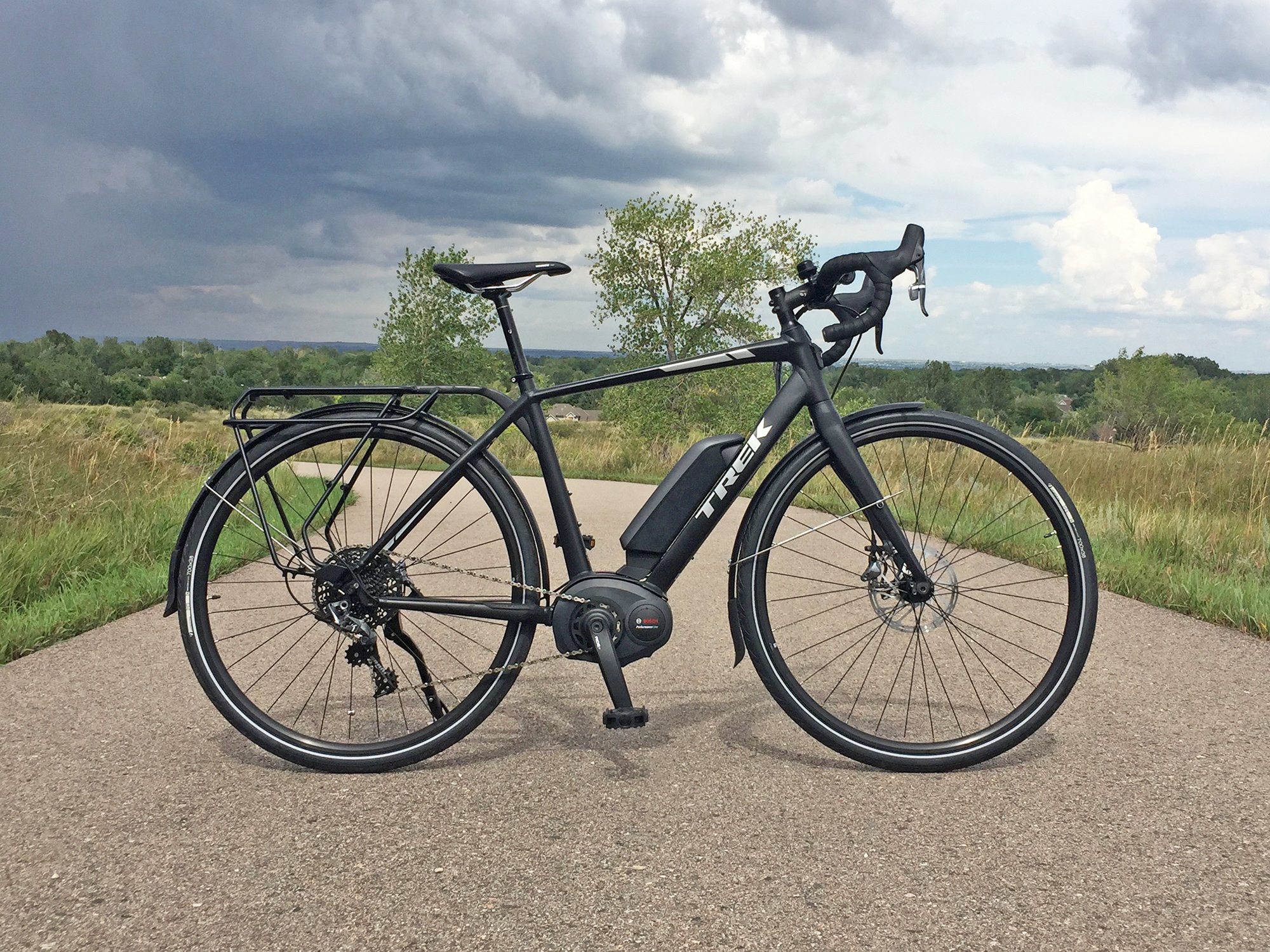
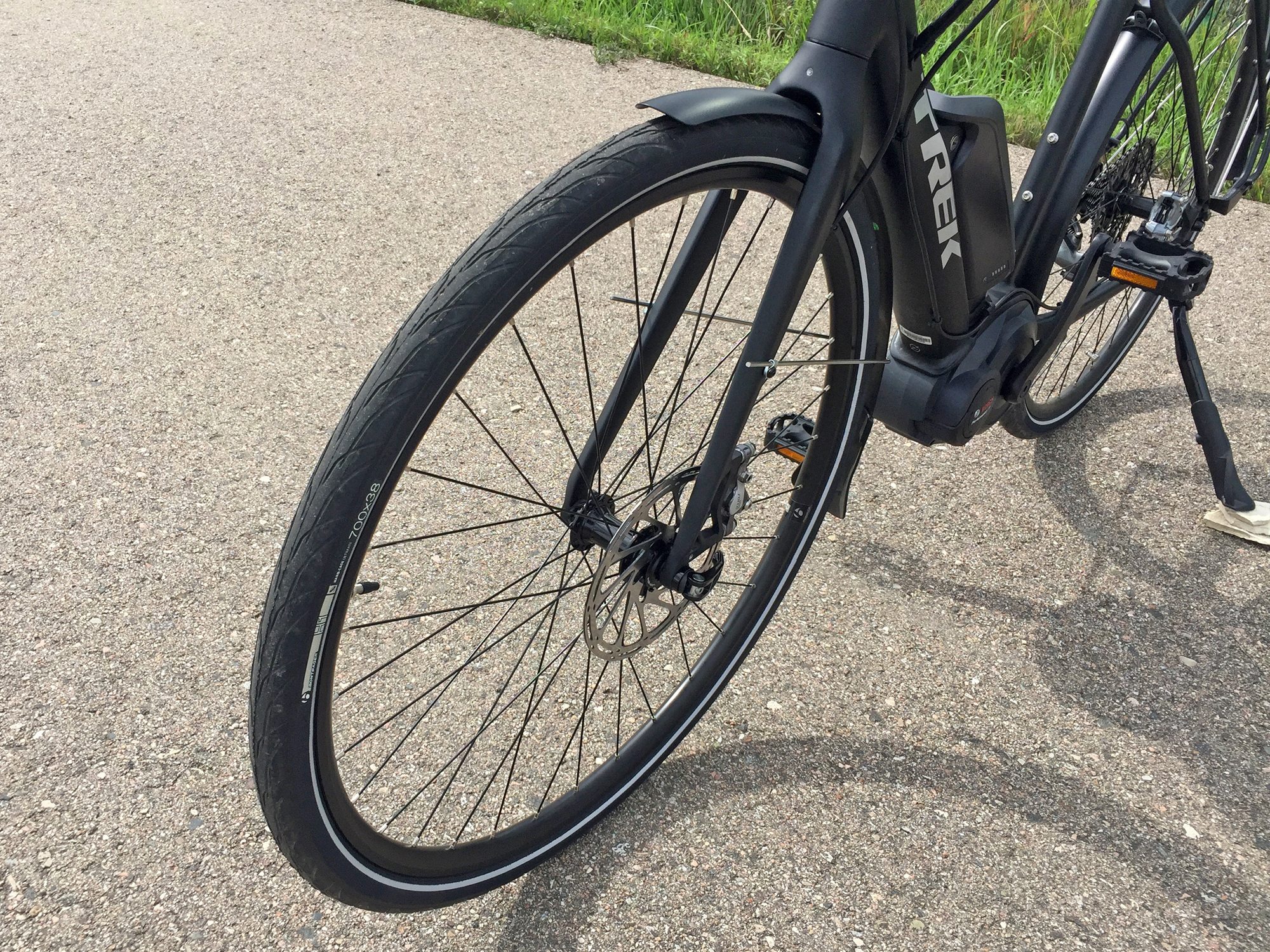
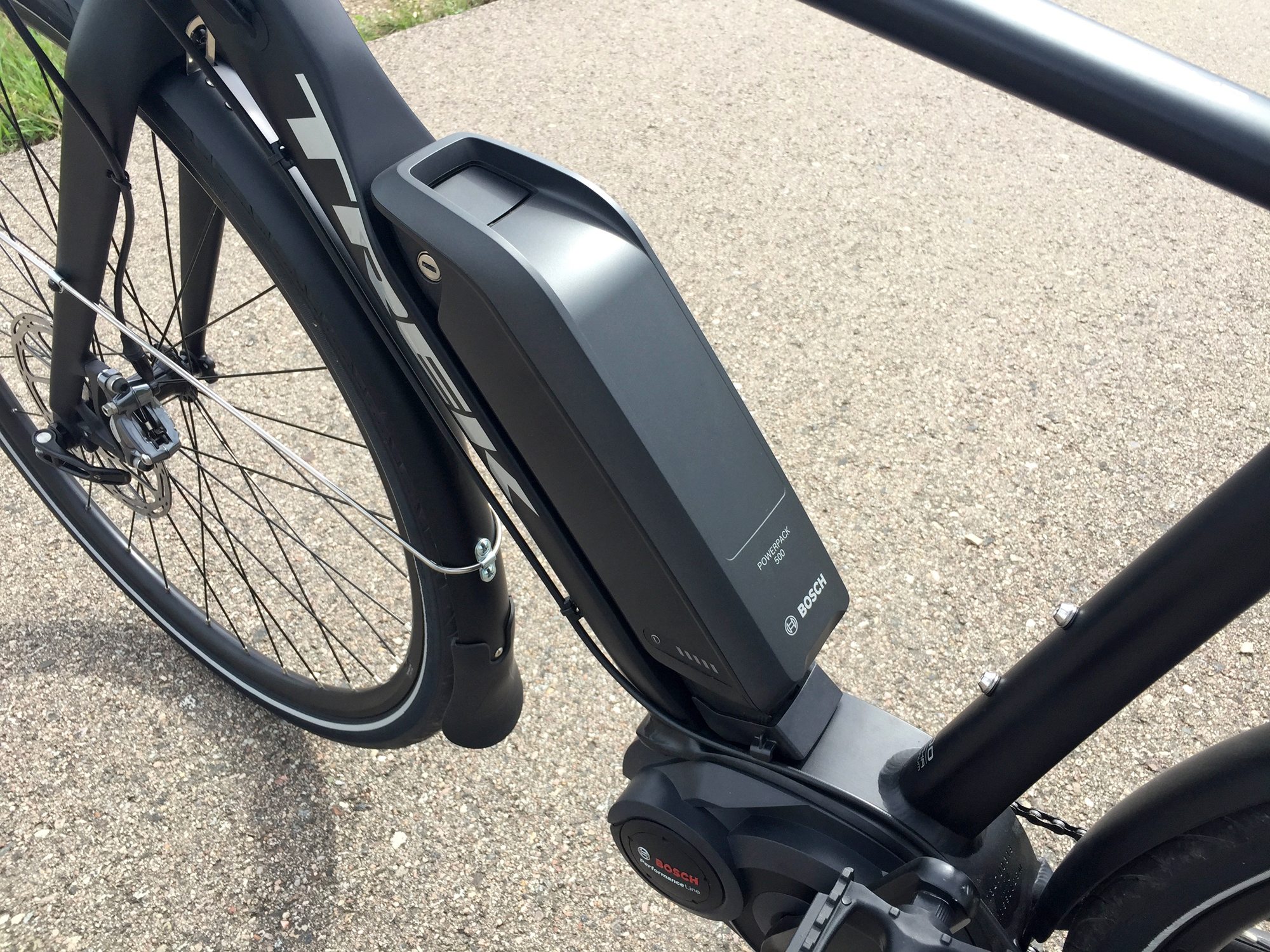
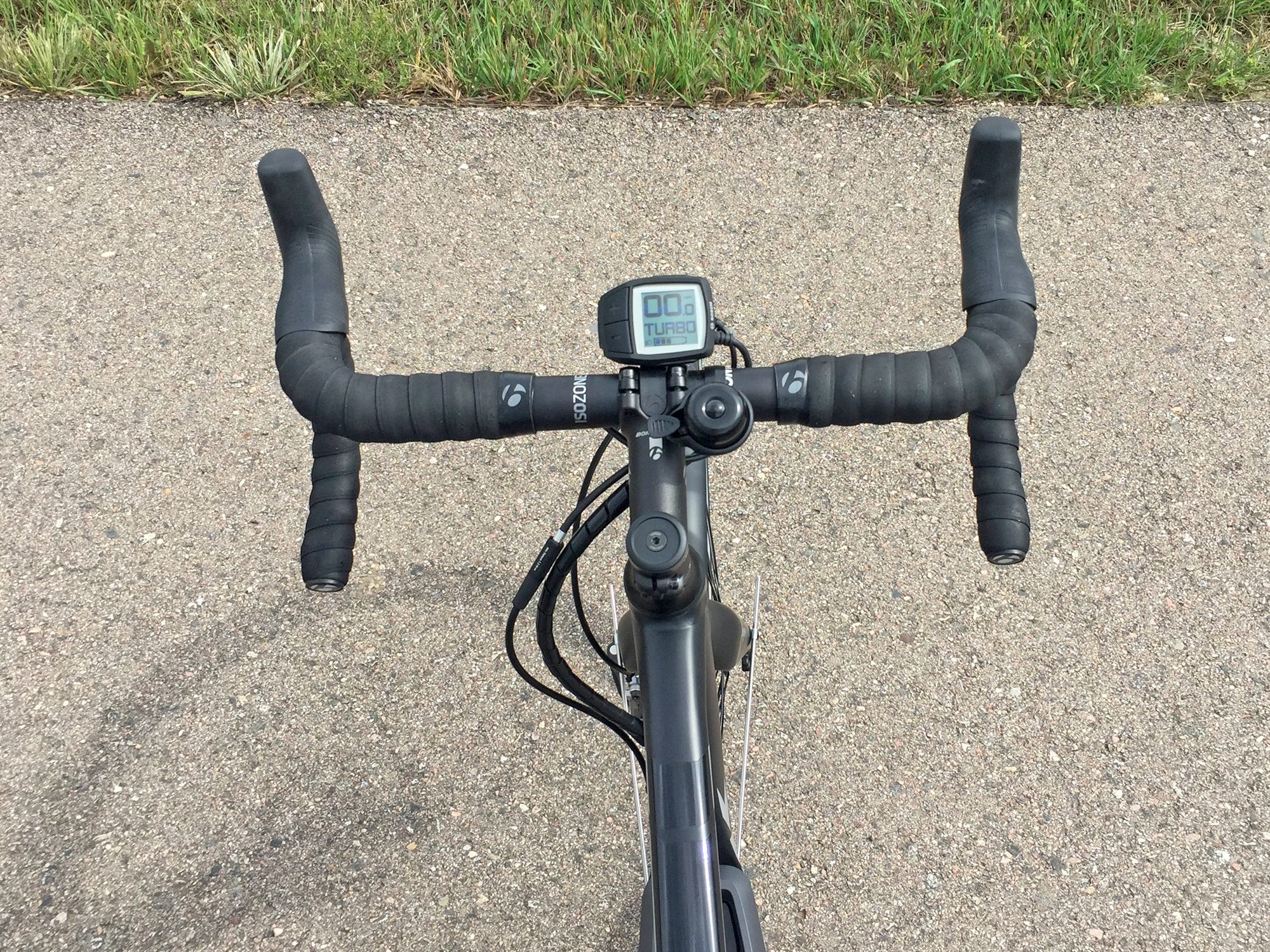
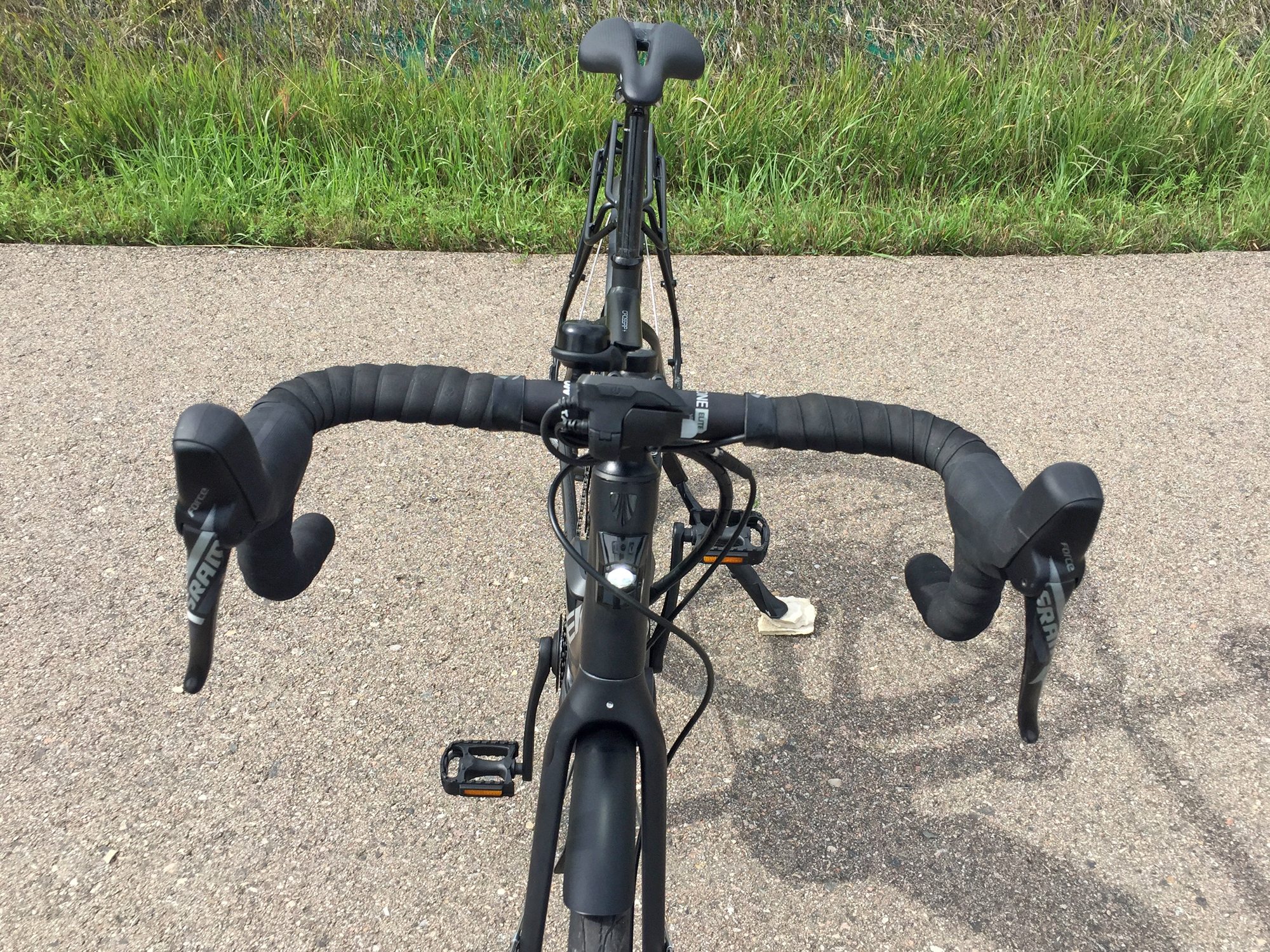
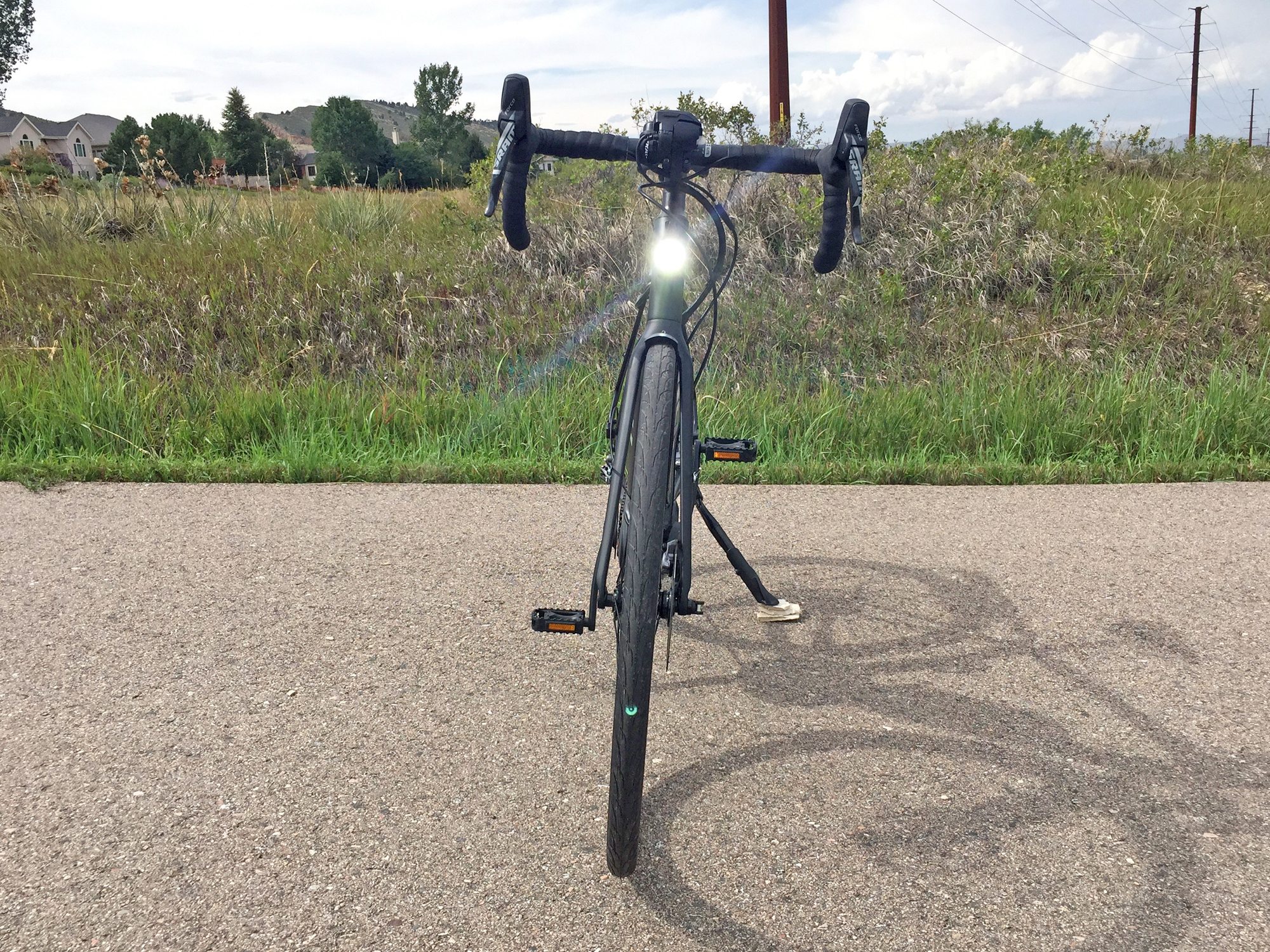
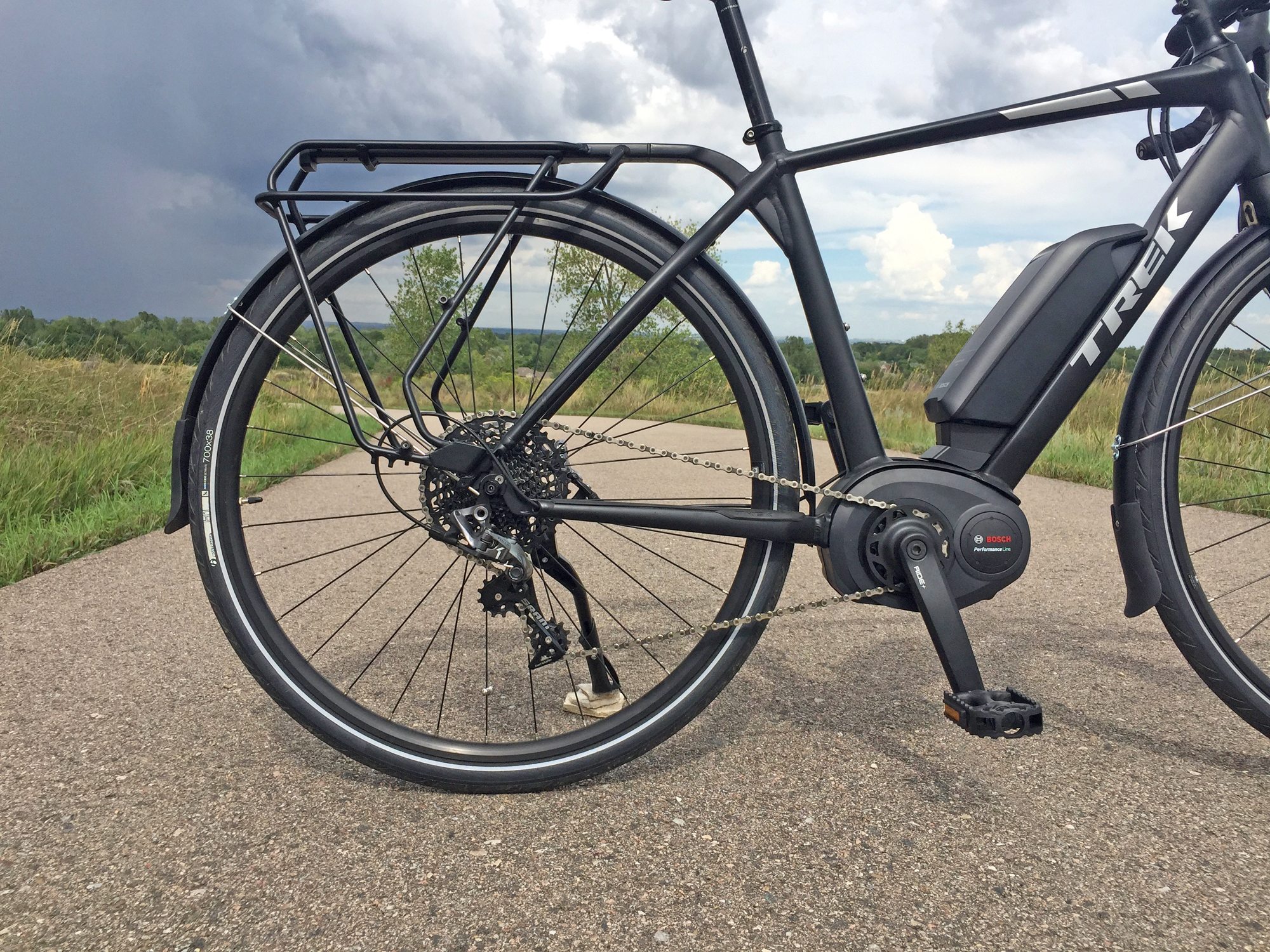
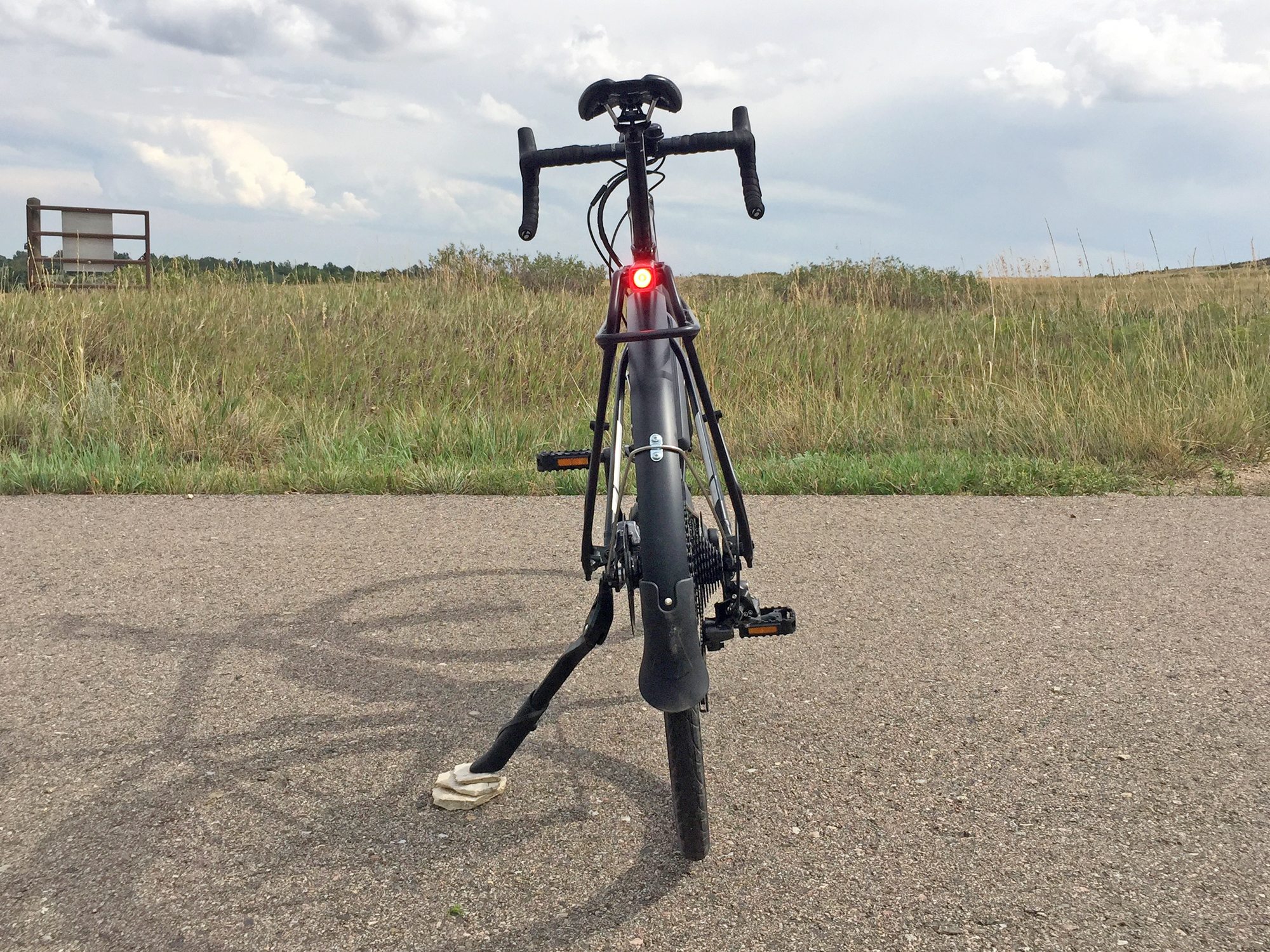
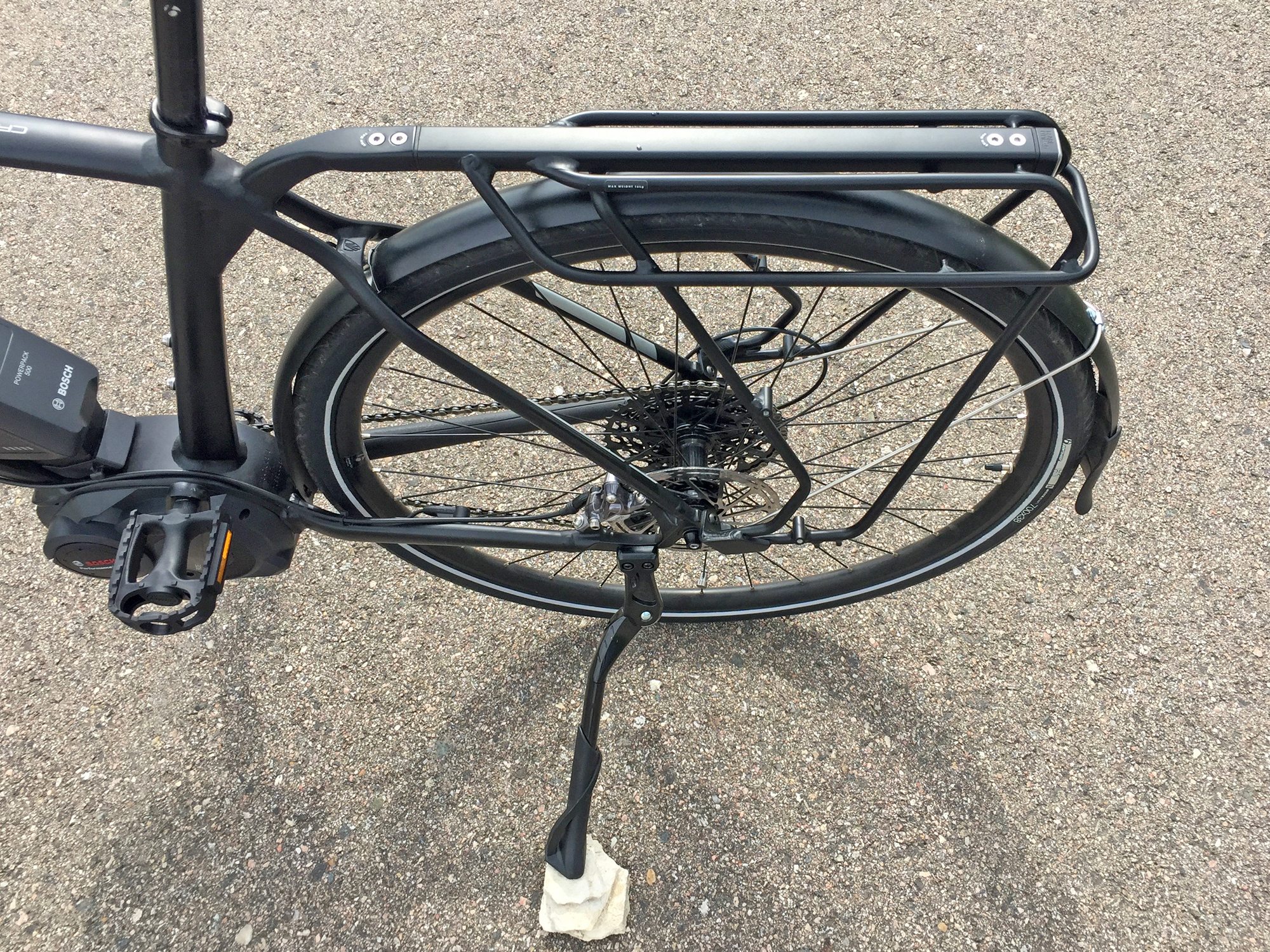
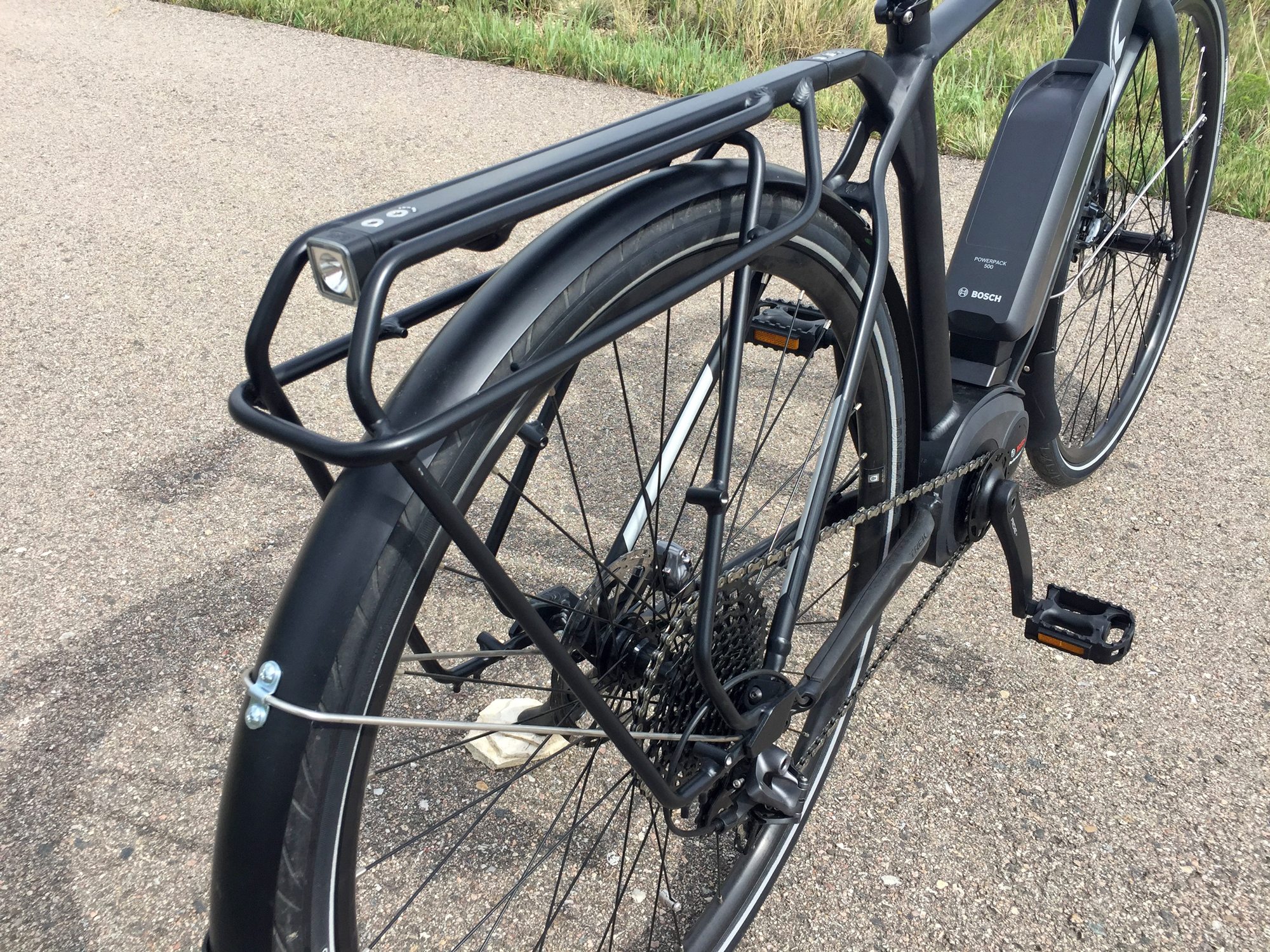
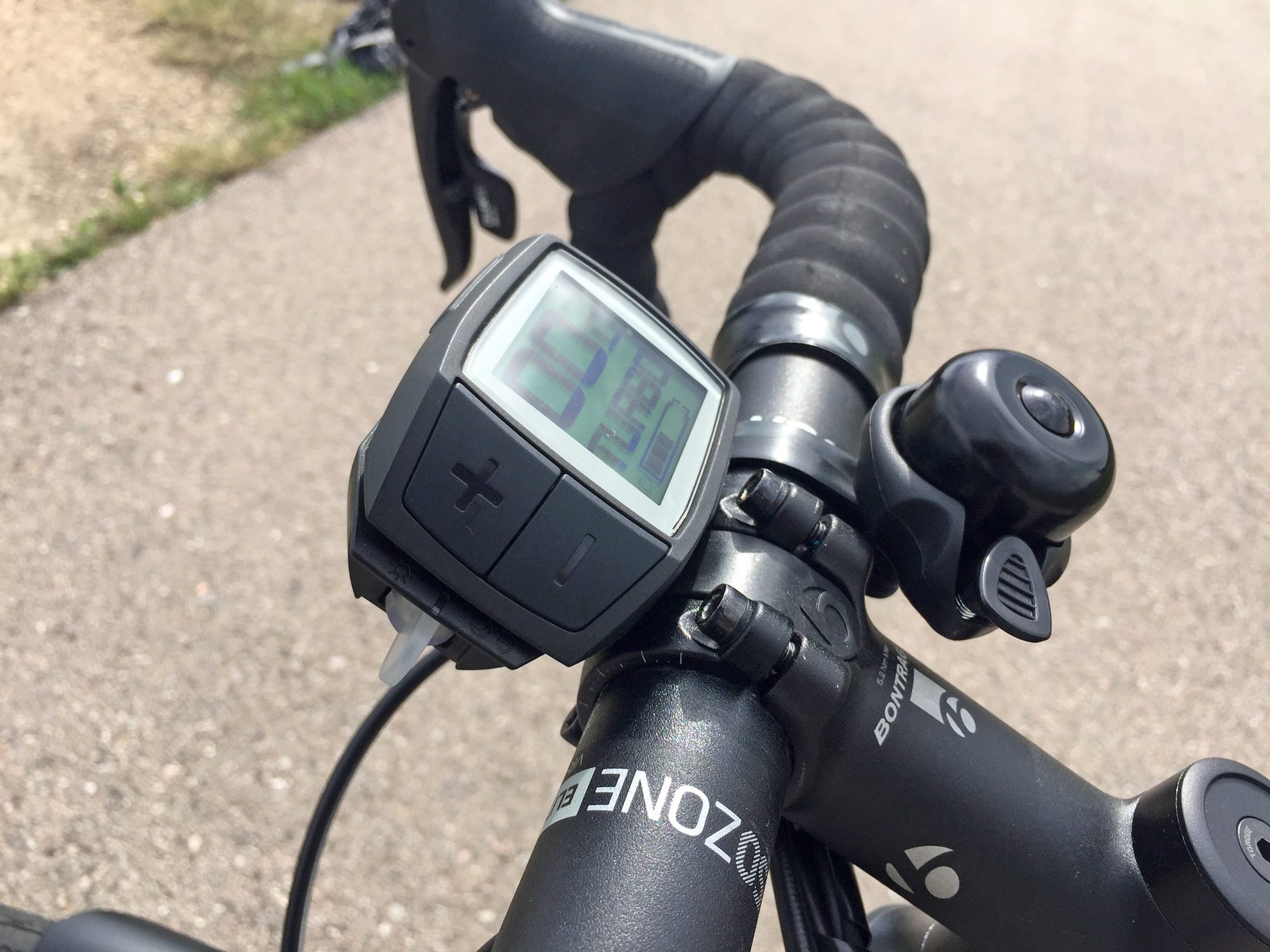
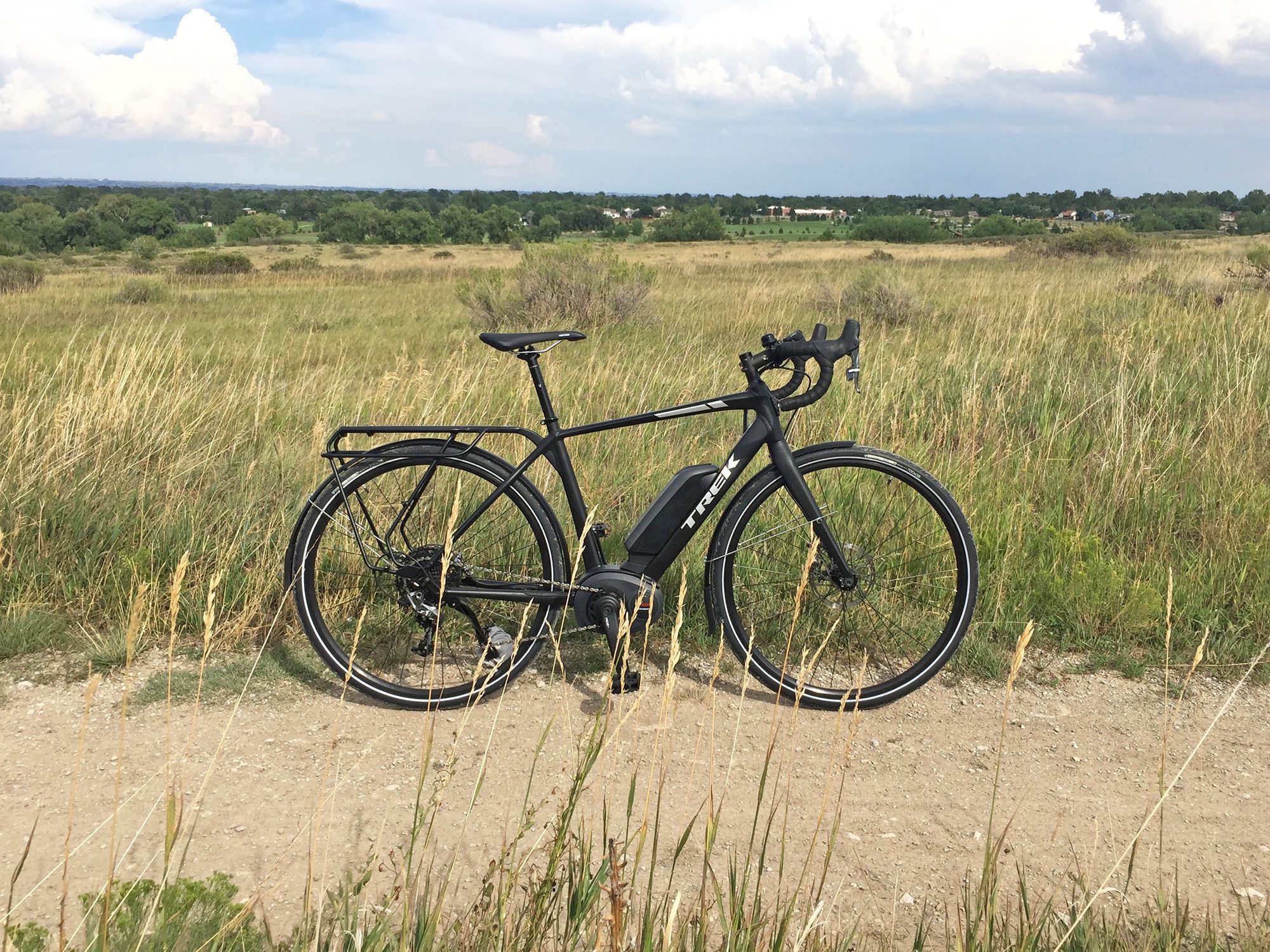

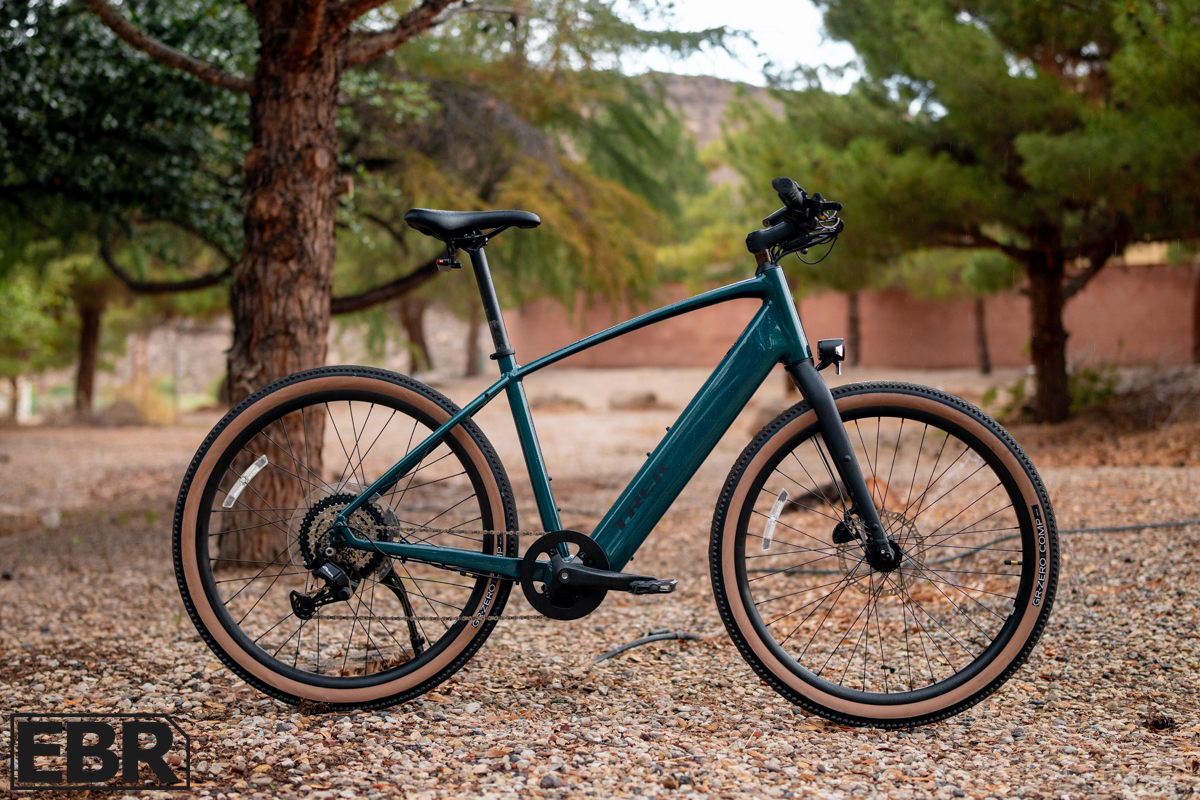
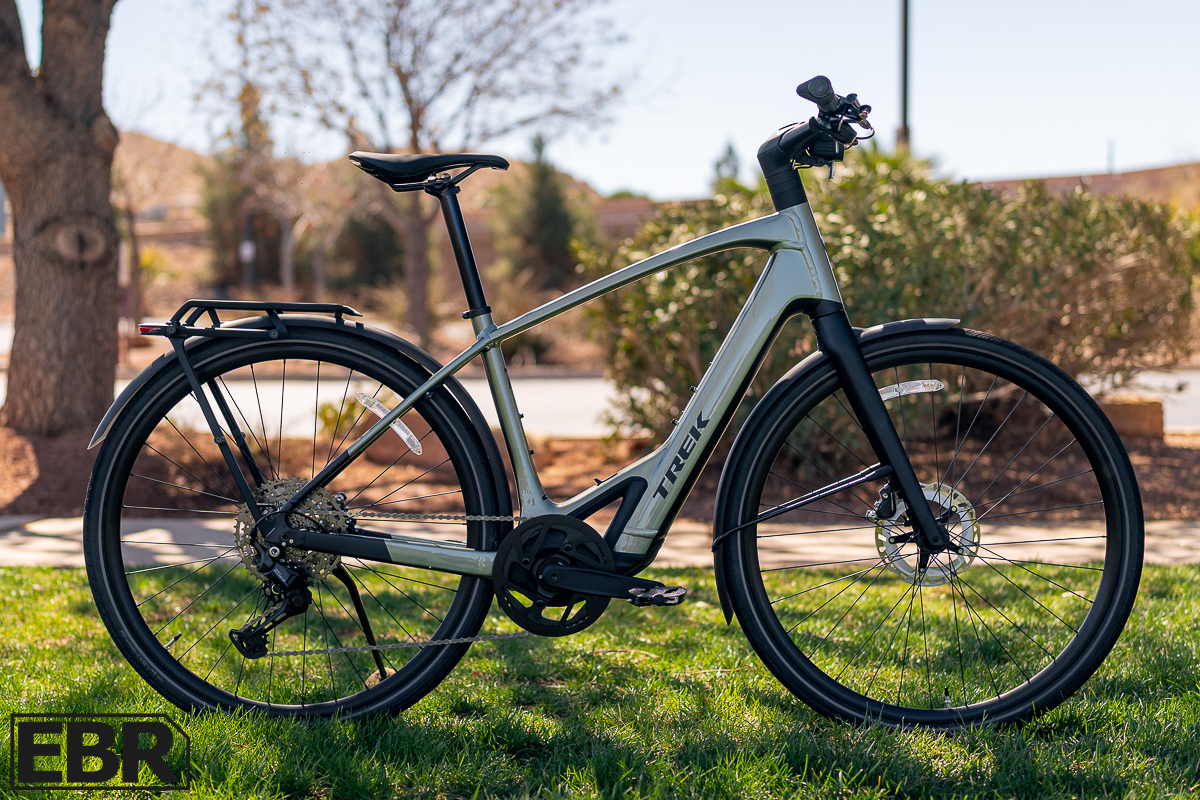
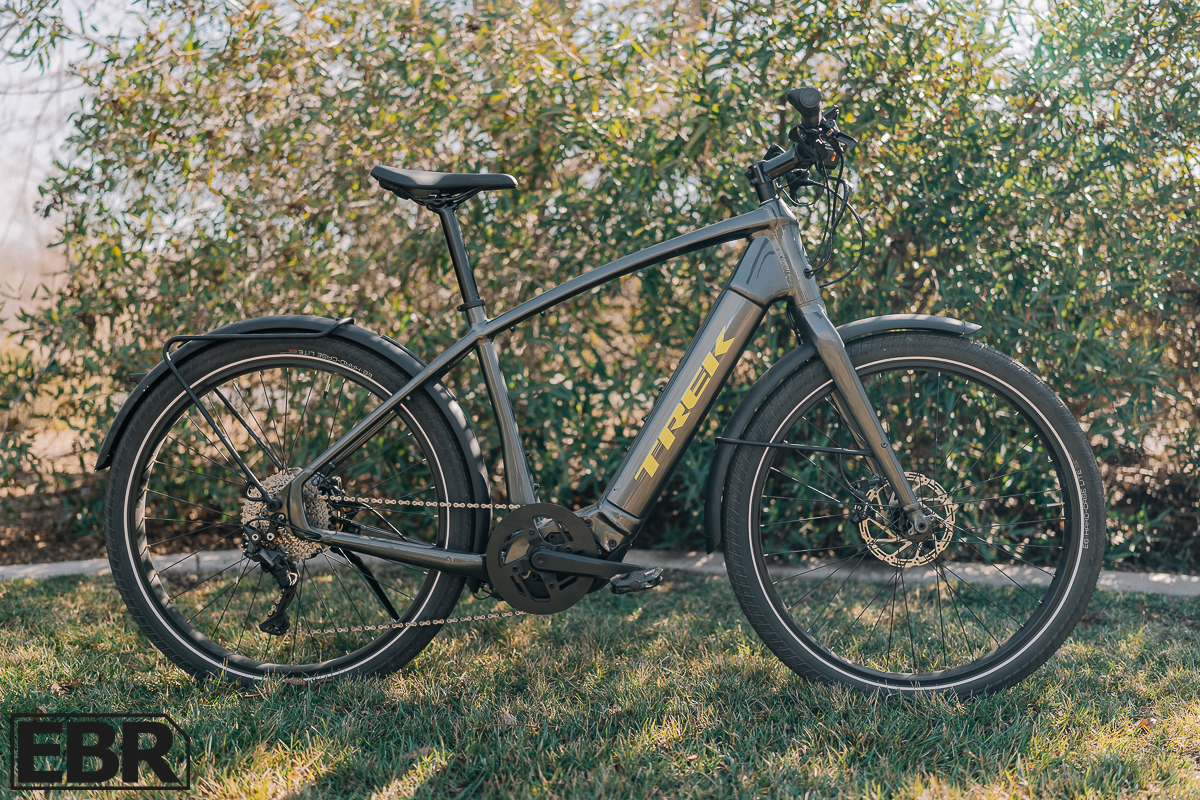
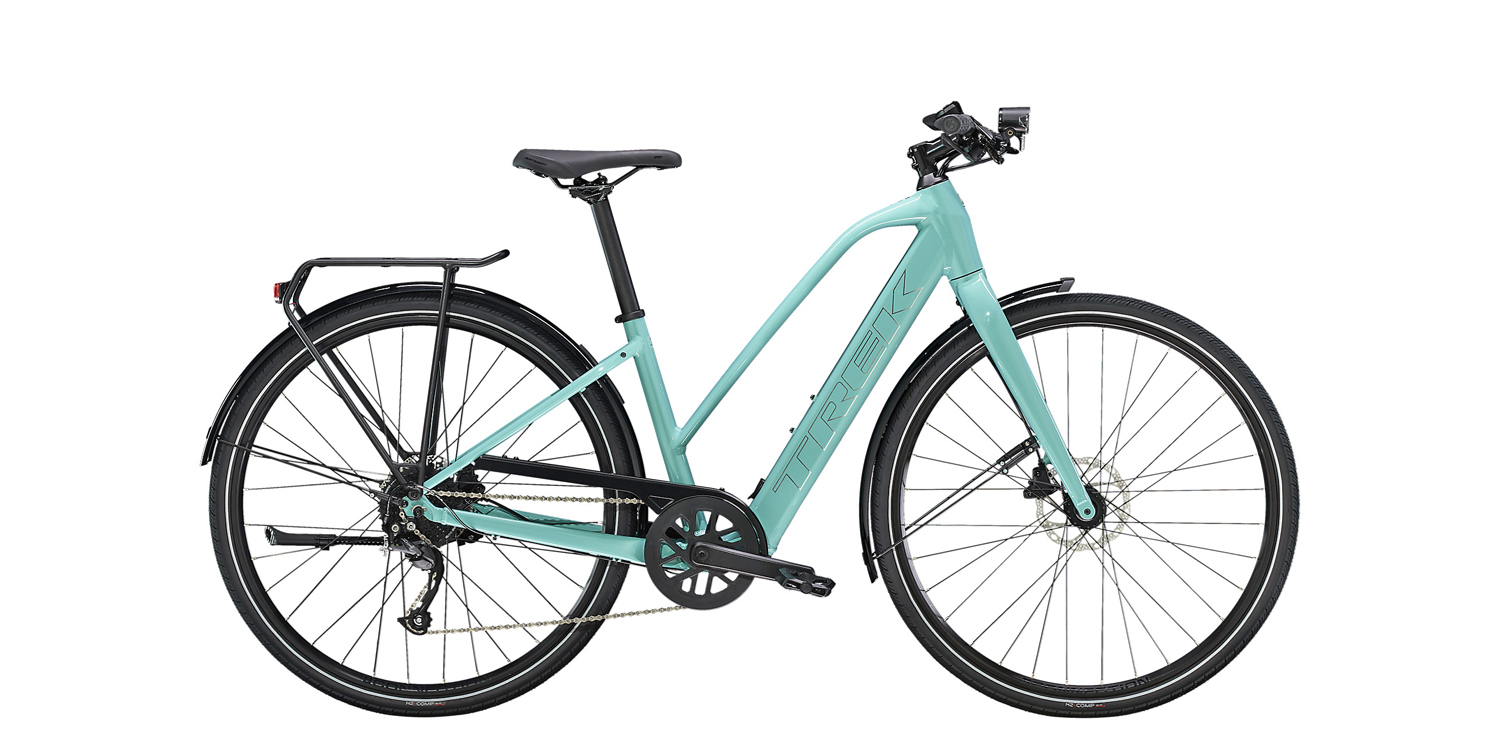
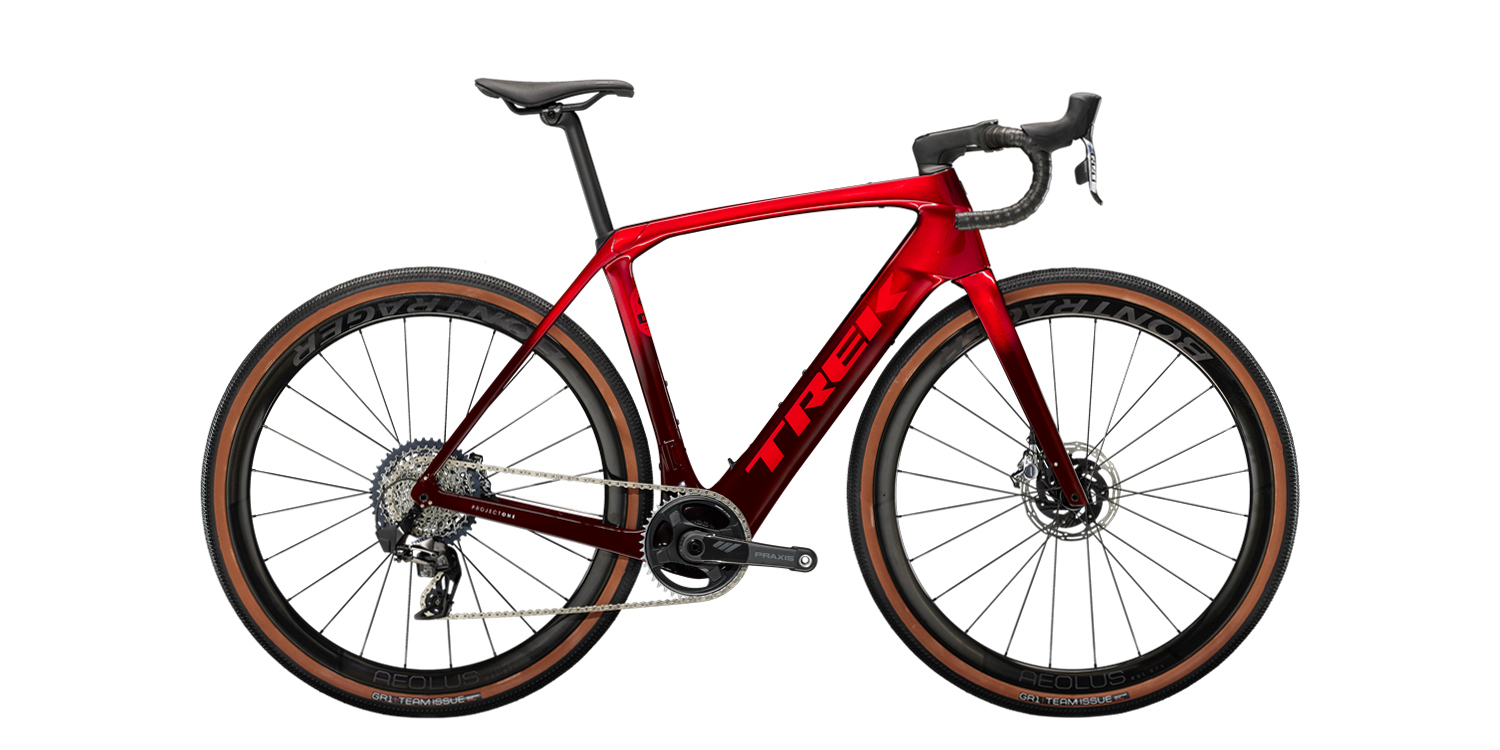
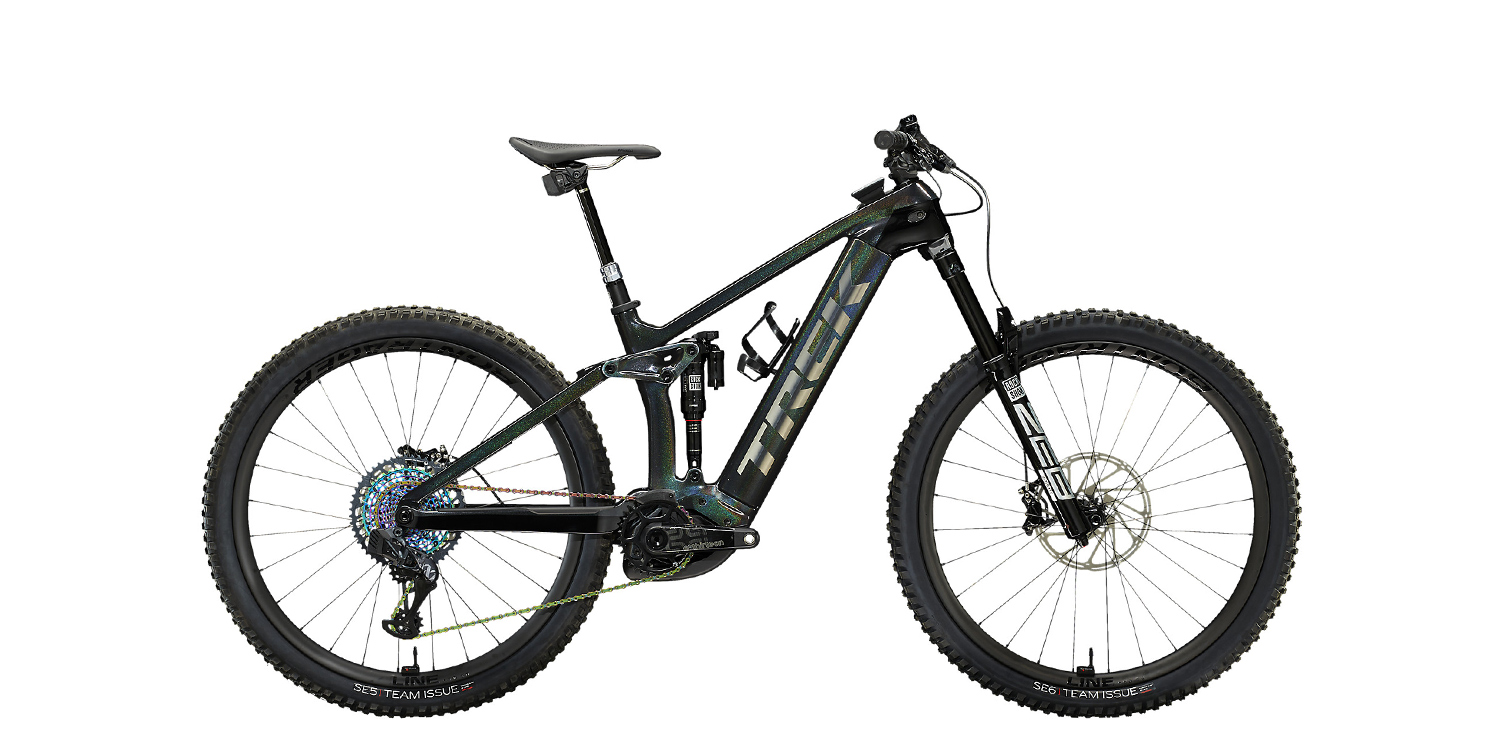
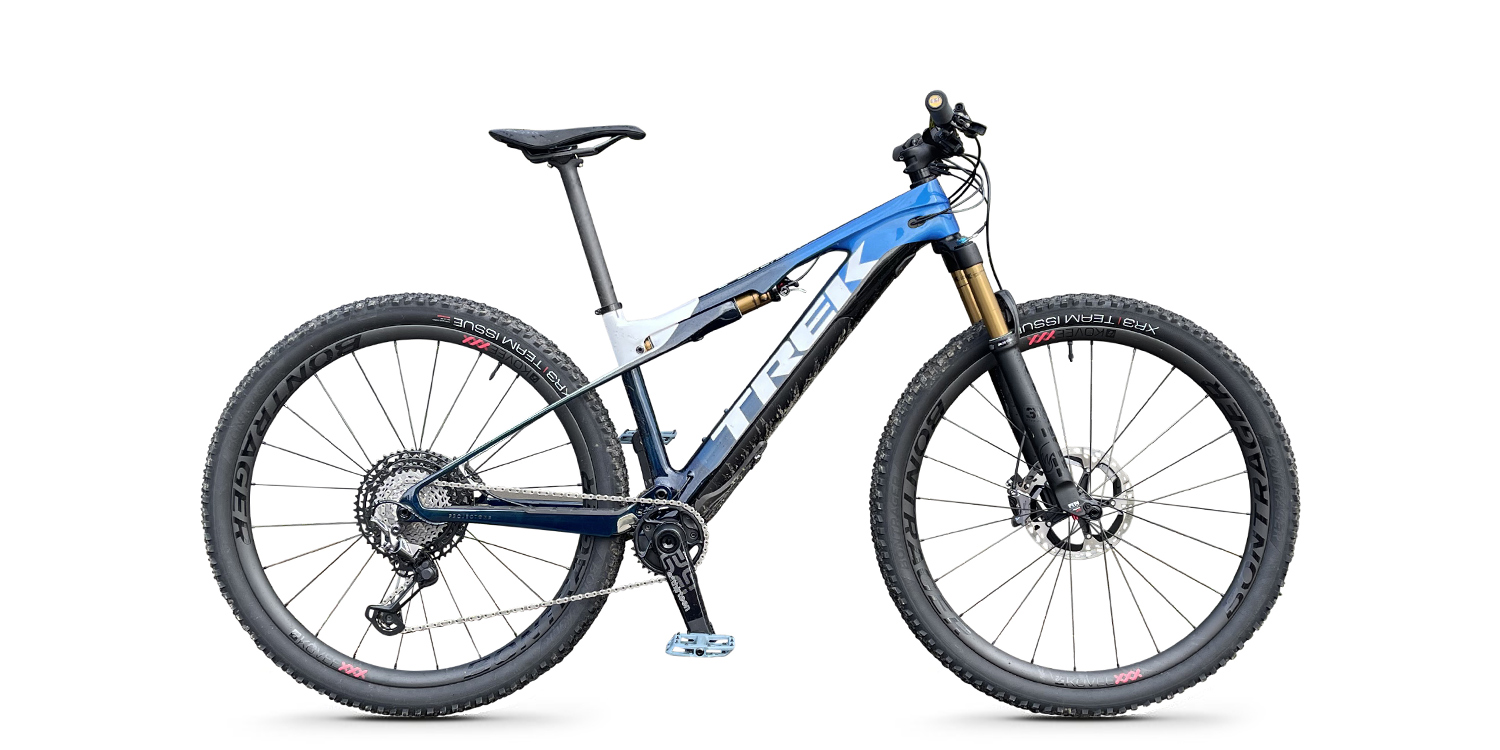
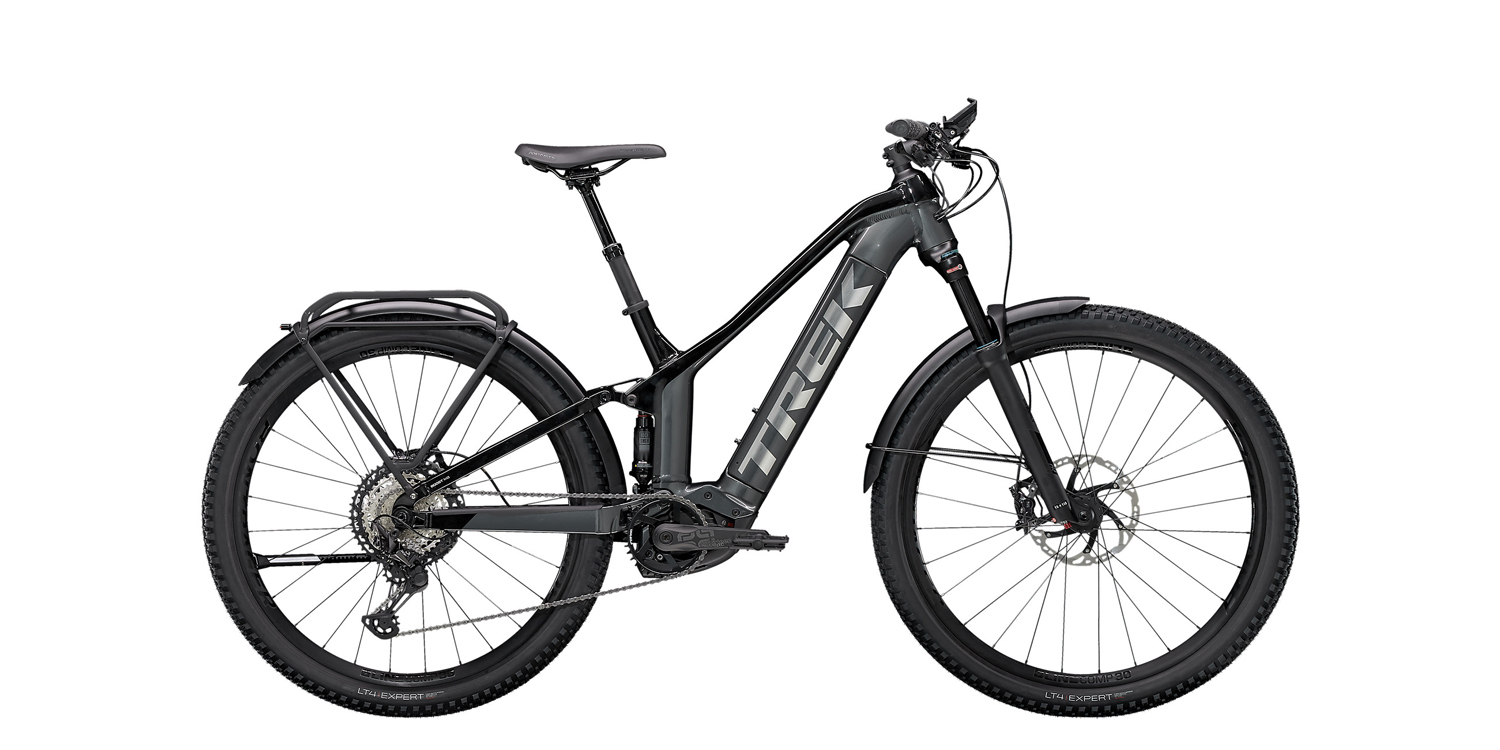
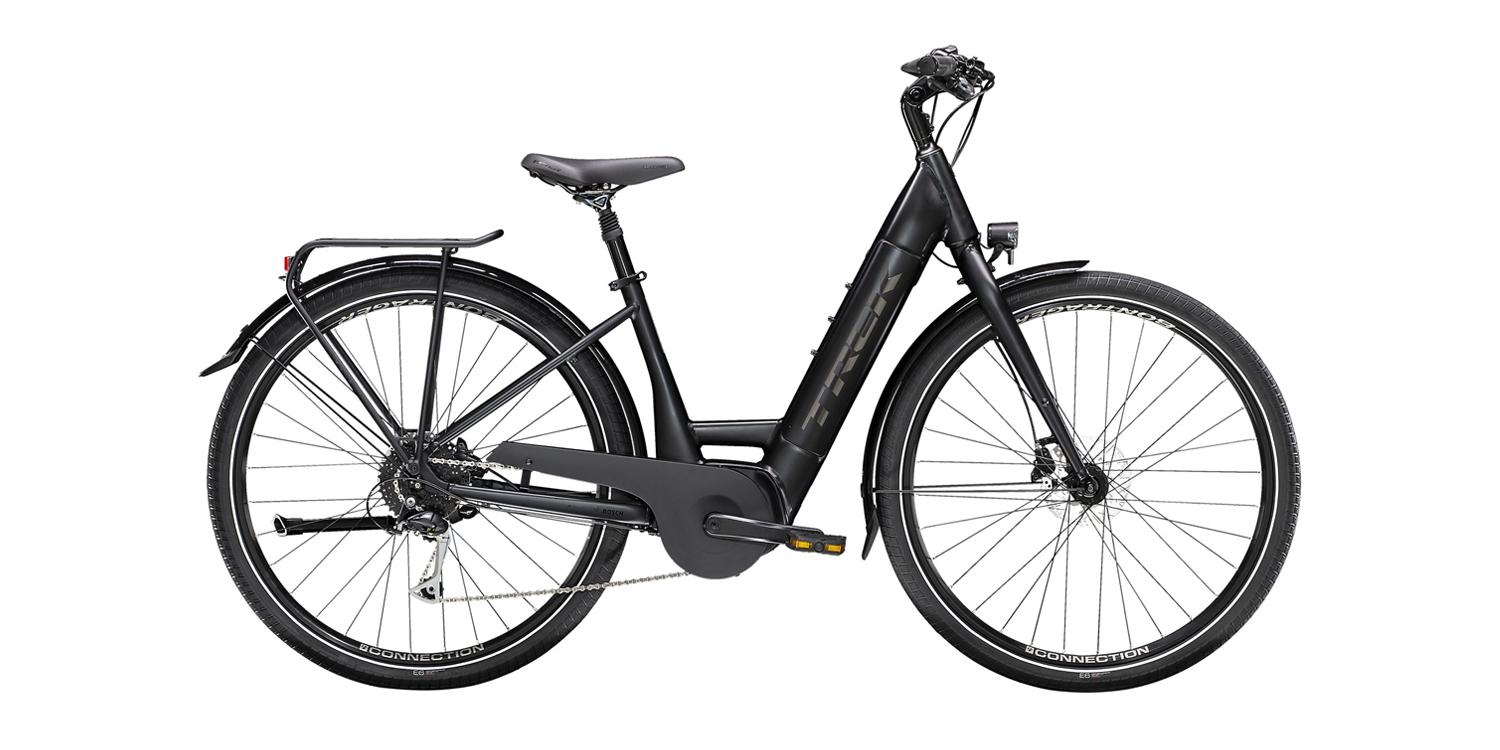
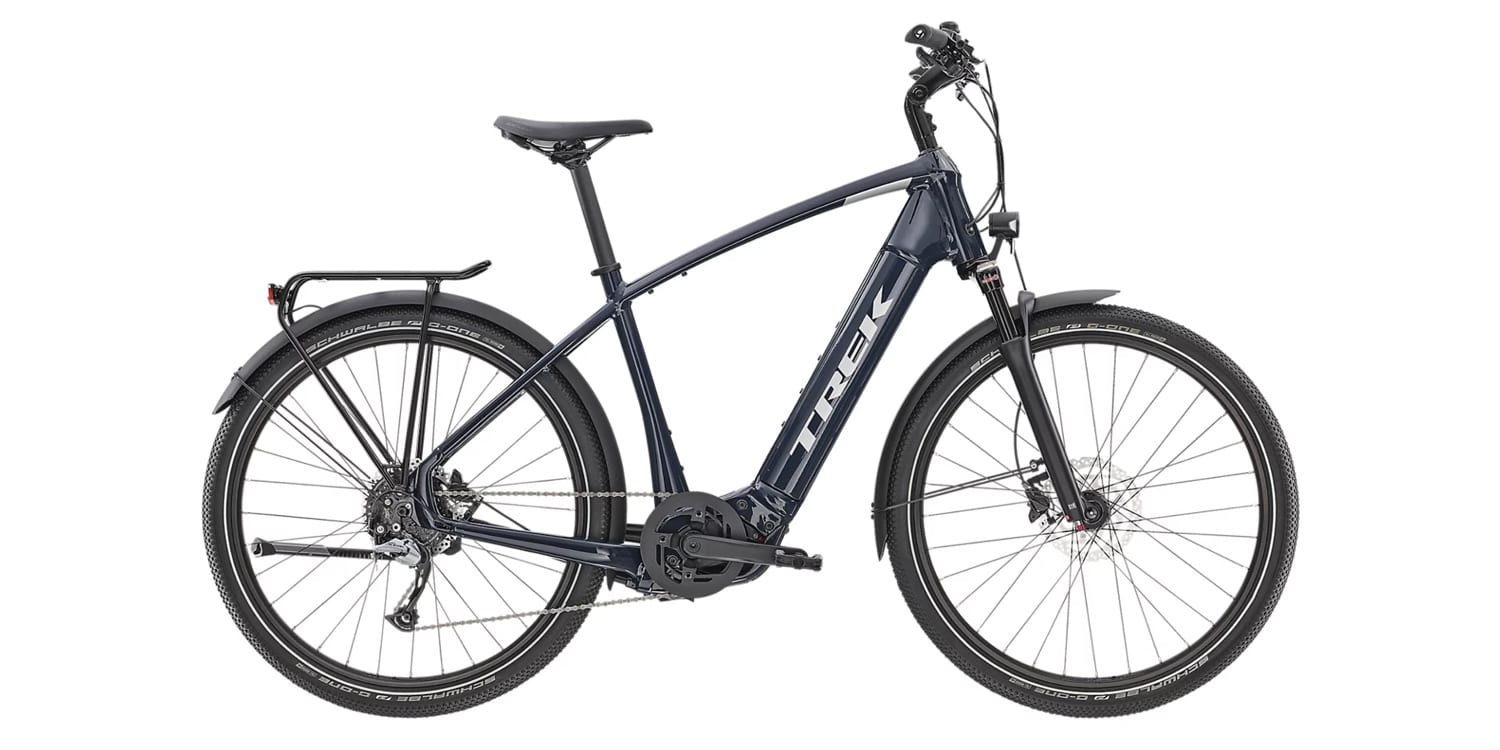
Hans says
I bought this bike because of the lighter weight, aerodynamic ride position, excellent components, integrated lighting system and commuter ready rack. Also because it had a short and predictable delivery time – Trek had plenty of these bikes in stock before they started selling them in California, so it took less than a week to get my bike delivered. I also like the Trek brand and dealer network.
I wanted an electric bike for my commute, which is about 15 miles each way, with a 500ft climb up to and over the Golden Gate Bridge. Most 28mph class 3 speed-pedelec bikes would probably achieve the ride in comparable times, and most other bikes would probably be quite a bit more comfortable than the Crossrip+. However, I wanted a bike that I could also ride at a decent speed under my own power.
My first ride to work took about 55 minutes. This is just over 16mph on average, which slower than I had expected, though significantly faster than my regular bike average of about 12mph. And the e-bike required a lot less effort of course. I had hoped that the ride would take about 45 minutes – which would’ve been 20mph average, but I hit plenty of red lights, stopped at all the stop signs, slowed down to 15mph on a bike trail, and also switched the motor off while crossing the 1.7 mile long Golden Gate bridge (abiding by the bridge authority’s rule). In downtown San Francisco I also had to slow down for other bike and car traffic.
On the ride home, I was able to keep the motor off all the way. I got up to 20mph fairly easily on flat sections (no headwind), and the 500ft climb with the 45lbs bike wasn’t too terrible in the lowest gear (the total weight for this bike plus my gear and my body weight is about 245lbs – which is only about 8% heavier than the total weight for my regular bike). The temptation to switch the motor on increased with every mile, and doubled when a regular road bike passed me, and quadrupled when a Stromer zipped by. But I held fast and made it home under my own power in 1h15. With the possible exception of a Giant Road-E+, I’m not sure I could’ve done this on any other e-bike.
Here are a few things I’ve noticed:
I swapped the standard pedals out for multi-function clipless/platform Wellgo WPD-95B pedals so I can clip in for long rides or ride comfortably with regular shoes. BTW, Wellgo has the most stunningly retro website I’ve seen, literally, in 20 years.
Court Rye says
Wow Hans! You win the comment of the day award, thanks for such a thorough and insightful writeup about the Trek CrossRip+ and your commute. I feel like you were very honest and fair about the trade offs and I’m sure this will help others who might be considering the bike for similar use. Indeed, Trek has purposefully disabled walk mode on all of their models. Maybe they are trying to avoid anything that could be construed as a throttle… but it seems a little overkill to me :)
Hans says
Thanks Court! Thank you also for the great reviews that you provide! You’ve helped so many people find the bike that works best for them.
Don49 says
Really nice follow up on Courtney’s always excellent reviews, I’m trying to decided between the Super Commuter and Cross Rip+. The Super Commuter seems to be a more tightly assembled bike especially where the battery is concerned. Do you find the battery is mounted securely? Also the Super Commuter has a shield under the motor, I didn’t notice one on the CrossRip+ do you find that to be a problem when you ride on gravel or wet weather? Thank you
Convert says
I bought the crossrip+ today. I am pretty sure I can drop Peter Sagan on climbs now. It has 4 modes. ECO, tour, sport and turbo. ECO is actually not bad. On climbs, turbo is unreal. When I raced road bikes a few years ago I would ride about 4,000 per year. Climbing is where I usually did best (USA cat 3). When I would get dropped racing with category 1 guys it happened in slow motion. I would dig as deep as I could and couldn’t push enough watts to maintain contact. If I said “hey guys, wait up!” They would hear me say that. Riding solo today, the speed I was able to climb on a bike that weighed about 3 times as much, plus the 35 lbs I gained in 3 years of inconsistent exercise is difficult to describe. When riding the crossrip, if one of the guys who used to drop me said to me “hey guys, wait up”, I would only hear “hey gu”
The acceleration is so strong and continuous that I would feel a little sorry for Peter Sagan if we ever crossed paths on the hilly roads around my humble split level home. Obviously the key is the hills. Yesterday was my birthday. My 2nd mid life crisis is in full swing. As I sit here eating leftover ice cream and cake I can’t wait for the Sun to come up to hop on this ebike.
court says
Happy birthday! Sounds like you’re having a blast… and now it’s okay to eat that ice cream and cake because you’ll be burning it all off, riding your bike :P
Thanks for sharing some of the excitement and your first impressions. These things really are a blast, it’s nice to get outside and feel the excitement, nature, and connection with friends who ride along. Keep it up!
David says
I’m confused as to how you can achieve such high speeds with that gearing. A 20 tooth front ring with a 11 sprocket on the back on a 700c bicycle at 90rpm is only around 17 mph. So how do you pedal up to anything close to 28mph. I must be missing something…. Could you explain this? Maybe I’m missing some magic of an electric bike. I was assuming it just added power to the crank but otherwise functioned like a normal bicycle. So wouldn’t I have to spin at some crazy speed to get close to 28mph?
Court says
Great question David, the Bosch Performance Line mid-motors use a proprietary sprocket that connects to the motor through a reduction gearing system. It spins 2.5x for each full crank revolution. The 20 tooth chainring is one of their larger sizes and is equivalent to a traditional 50 tooth chainring (2.5 x 20). This reduction gearing design introduces a slight bit of drag when pedaling unassisted or beyond the maximum assisted speed of 28 mph. It also introduces some extra noise, but the smaller sprocket provides excellent chain retention and starts and stops very quickly. I suspect that eventually, Bosch will move to standard sized chainrings for all of their motor systems. They have already done so with the Active Line and you can see an updated version of that motor here. It’s just not as powerful or fast as the Performance Line Speed motor on the CrossRip+
Eric Breidenbach says
I have appreciated the attention to detail that goes into these videos and written reviews. Thank you Court. Seriously consdering the CrossRip Plus: I have a couple of questions:
Court says
Lots of good questions there, Eric. I think it probably is ideal to keep the battery in a central range… whether that’s 20% to 80% or the 30-60 you mentioned. Bosch is a bigger company that has spent more resources on drop tests, overcharge tests etc. and I suspect that their charger and controller are designed to limit wear on the pack. I wouldn’t lose too much sleep over this… my Uncle still has and uses his original Haibike battery and it has been several years. He rides every day and only has a PowerPack 400!
I don’t know much about the 2019 Crosrip, haven’t seen it in person or researched it yet, sorry. You should easily be able to do your commute with lower levels of assist and if you don’t go above 20mph the whole way. Speed pedelec motors (like the Bosch Performance Line Speed) definitely use more power, but this ebike is so efficient with the skinny tires and lightweight aero design. The big factors are tire pressure, rider weight, hills, and which level of assist you ride in. Wind can also make a difference. Yes, price is a big deal here… there’s an opportunity cost in waiting, but this is one of the nicer road style ebikes on the market. I did see a new Trek road-ebike with PowerTube battery, that looks really nice. I’m not sure if it’s the CrossRip or what, but it was shown in my Bosch Interbike video here, towards the end. I hope this helps :)
Byron Mucke says
Hi Court,
I am sure you already know what the bike is but just in case somebody is doing research on the Crossrip the bike shown in the video that uses the PowerTube is the Domane+. Thanks for all the great reviews and in depth coverage.
Byron
Court says
Thanks for this info Byron! And, thanks for your business in the past with Hill Topper. Brent covered those models but I hope that you and I get to work together more directly in the future. I respect your company, you’ve been around for a long time and always offered a lot of value and some great DIY solutions. Hope you’re well :)
Ray Bane says
I recently visited the Trek dealer here on Maui to order an ebike. I expressed interest in both the Verve+ and Crossrip+ models with a preference for the Crossrip. When the store rep called Trek to determine availability they were told that neither was available in my size. (I am 5′ 5″, 150lb, 82 yr. old avid biker riding an average of 20 mi. 4-to-6 days a week). I was also advised that Trek would soon be producing a new line of ebikes for 2020 and that the new models would likely replace the externally mounted battery with a battery that would recess into the downtube. I was disappointed with the fact that the two models I found particularly attractive would likely be discounted. I prefer the battery mount on the current Verve and Crossrip and planned to purchase a backup battery for longer trips. I also hoped to add some additional extras (shock absorbing seat post, Frog pedals, carrier bags, etc.). Is there any possibility of obtaining a Crossrip + or Verve+ before these models are discontinued?
Court says
Hi Ray! I feel you, my preference was for the external battery as well because it’s lighter and easier to use with additional packs. Unfortunately, it might be difficult to find and then very difficult to ship one of these prior-year (or current year) models to Maui. If your shop isn’t in a position to have one transferred within their company/supplier then it might be time to consider a similar ebike that does have the battery you want? I had heard that Trek was selling through on some of these more popular models. Sorry man :(
Ray Bane says
Thanks for the feedback, Court. I too think that Trek is making a mistake by discontinuing the Crossrip+. Perhaps it’s my age and working class background, but the Crossrip impresses me as a working person’s ebike. It has design features that give it a solid middle class, “by your bootstraps” character. Today’s elders (65+yrs.) are far more physically active than they once were. They want to stay in good physical shape – and they want to get out and interact with the environment and other active seniors. The Crossrip+ has the basic style and no-nonsense features that are uniquely American. Trek would be well advised to continue producing the Crossrip+ and to focus on serving the active senior movement.
Court says
Well said, Ray. I appreciate the time and care you’ve invested in this response and perhaps Trek will see it. My primary contact switched companies recently, but Trek is still one of my favorites in the industry and seems to be doing quite well. I will pass this on to my next contact and wish you well in finding a good alternative. Perhaps there is a BULLS model that would fit the bill, they have a wide range of products to offer and good customer support in my experience.
Andy says
Any news on what they are going to replace the crossrip+ with? I live and work in San Francisco and want something for commuting + the occasional trip across golden gate up to Marin. I have been waiting since July to buy an eBike but should probably just pull the trigger and get something else. Do you know if something like the Luna Fixed Stealth or VanMoof would make it up San Francisco’s hills with ease?